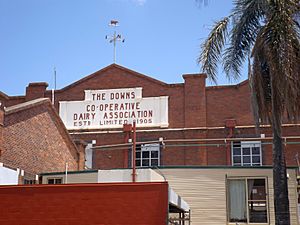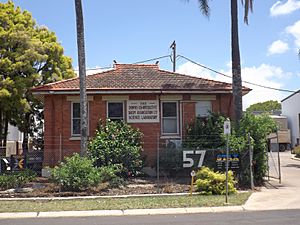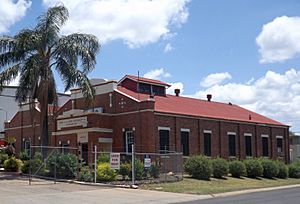The Downs Co-operative Dairy Association Limited Factory facts for kids
Quick facts for kids The Downs Co-operative Dairy Association Limited Factory |
|
|---|---|

Main building, 2014
|
|
| Location | 57 Brook Street, North Toowoomba, Toowoomba, Toowoomba Region, Queensland, Australia |
| Official name: The Downs Co-operative Dairy Association Limited Factory (former), Dairy Farmers Factory | |
| Type | state heritage (built) |
| Designated | 18 April 2008 |
| Reference no. | 602596 |
| Significant period | 1920s |
| Lua error in Module:Location_map at line 420: attempt to index field 'wikibase' (a nil value). | |
The Downs Co-operative Dairy Association Limited Factory is a special old factory located at 57 Brook Street in North Toowoomba, Queensland, Australia. It's also known as the Dairy Farmers Factory. This factory is important because it shows how the dairy industry grew in Queensland. It was added to the Queensland Heritage Register on 18 April 2008, meaning it's protected for its historical value.
A Look Back: The Factory's Story
The Downs Co-operative Dairy Association Limited Factory played a big part in the dairy industry in Queensland. It helped the Darling Downs area become a major place for making dairy products from the early 1900s to the mid-1900s.
The first butter factory here was made of wood and built in 1905. Later, in 1929, it was rebuilt using brick and concrete. Over time, more buildings were added as the dairy business grew. These included an office building in the early 1930s and a science lab in 1936. Other buildings for engines, refrigeration, and power were also built around the 1930s. A factory for processing milk and cheese was added in the late 1930s or early 1940s. More changes and additions happened after the 1940s.
How Dairying Grew in Queensland
By the 1890s, the Queensland Government wanted to grow more farms, especially dairy farms. They saw this as a way to help more people settle the land and boost the economy. New technologies helped dairying grow. These included refrigerated shipping from 1883 and mechanical cream separators in the late 1880s. The Babcock test also helped farmers check the fat in milk.
The government helped in many ways. They had "Travelling Dairies" that showed farmers new techniques. They also started grading butter and passed laws to help set up co-operative butter and cheese factories. They also spent a lot of money building new railway lines. These lines helped farmers send their dairy products to markets.
Dairying's Importance to Queensland
From the 1910s to the 1960s, dairying was very important for Queensland's economy. It brought in money from selling dairy products at home and overseas. It also encouraged more people to settle on farms. During the economic hard times of the 1930s, dairying was the biggest farming activity in Queensland. Regular payments from selling cream helped many families survive. Between 1936 and 1941, dairy products were Queensland's second most valuable export.
The Co-operative Idea
The idea of co-operatives started in Switzerland. In a co-operative, farmers own shares in the company that processes and sells their products. This idea came to Queensland from Victoria. In 1901, some dairy farmers tried to start a co-operative on the Downs, but it didn't work at first.
In 1904, the idea was brought up again. Farmers decided to build a butter factory near the railway in Toowoomba. They wanted the company to be owned only by farmers. They bought land next to the Southern and Western Railway on Brook Street. Construction began in 1905, and the factory opened in November 1905.
The co-operative chose "Unity" as its brand name. This name showed their idea of strength in working together. The factory made money right away. Its success encouraged other dairy co-operatives to form. After the Toowoomba factory opened, the number of dairy cows on the Darling Downs grew a lot. By the 1950s, the Darling Downs produced over 25% of all dairy products in Queensland.
Growing the Business
The Downs Co-operative Dairy Association quickly grew. They built or bought other butter factories in places like Miles (1911) and Dalby (1915). World War I (1914-1918) led to more cheese making in Queensland. So, the Co-operative also set up or bought cheese factories in places like Hodgson Vale (1915) and Jondaryan (1919). However, the Toowoomba factory remained the main office and biggest factory for the Co-operative.
In the late 1920s and early 1930s, the Co-operative was doing well. They rebuilt some of their wooden butter factories with concrete and brick, including the Toowoomba factory in 1929. But during the hard economic times of the early 1930s, they had to close some of their cheese factories.
When the Toowoomba factory was rebuilt, the old wooden parts were removed section by section. New concrete and brick buildings were put in their place.
To make sure their "Unity" products were always high quality, a science lab was built at the Toowoomba factory in 1936. In 1938, the Co-operative got the special right to sell pasteurised milk in Toowoomba. New facilities were built to pasteurise and bottle milk. By 1939, all milk for the Co-operative was sent to Toowoomba. This helped them make cheese more efficiently, leading to more growth and further additions to the factory by 1940.
World War II (1939-1945) created a huge demand for Australian farm products. With many American troops in Queensland, the Darling Downs saw a big increase in butter, cheese, and milk production. After the war, milk production stayed high. Milk from the Toowoomba factory was sent by train to far-off towns and by road to Brisbane. In 1953, a new plant was opened to make concentrated and dried milk products.
Important People in Dairying
The Downs Co-operative Dairy Association worked closely with two important people in the Australian dairy industry: James Purcell and James Henry Cecil Roberts. These men helped the Co-operative influence dairy policies across Queensland and Australia.
James Purcell was a key leader in the dairy industry. He helped start the Downs Co-operative Dairy Company in 1904 and was a director for many years. He played a big role in shaping dairy policies for the state and country.
James Roberts was also a director of the Co-operative. He was important in Queensland's political and economic history. He helped found the Darling Downs Farmers Union and the Queensland Country Party.
In the 1960s, the Co-operative started making more cheese and milk products like yoghurt. This was because they knew Britain would join the European common market in 1973. This meant Australia would lose a big overseas market for butter. This change led to a reduction in dairy farming in Queensland. Many smaller factories closed, and some dairy farms became grain farms. However, the Toowoomba factory stayed strong. In 1985, a new milk powder factory was built there.
Later, changes in Queensland's dairy industry between 1998 and 2003 led the Co-operative to reorganize. This meant the Toowoomba factory eventually closed in 2006.
What the Factory Looks Like
The Downs Co-Operative Dairy Association Ltd Factory is a group of buildings made of brick, concrete, and metal. These buildings were built from 1929 to the 1990s. The factory sits on a long, narrow piece of land between the railway line and Brook Street in Toowoomba. The older brick and concrete buildings have been changed over time, but they still have many original parts inside.
Here are some of the important buildings on the site:
Administration Building (around 1930)
The office building is at the northern end of the factory, near Brook Street. It's a single-storey brick building. It has special lintels (beams above windows) over the windows facing the street. The front of the building has the company's name and the year it started carved into the wall.
Inside, the building has a typical office layout with rooms for staff, a meeting room, and filing rooms. Many of the original features are still there, like Art Deco-style counters and built-in safes.
Laboratory (Science Building) (1936)
The lab is next to the office building, also facing Brook Street. It's a single-storey brick building with a terracotta tiled roof. It has special windows with multiple small panes in the upper part. On the Brook Street side, there's a section of wall with the words "The Downs Co-Operative Dairy Association Ltd Science Building" in raised letters.
Inside, the building has five small rooms. Many original lab items are still there, such as fume cupboards, lab benches, and sinks.
Engine and Refrigeration Building (around 1930s)
This two-storey brick building is close to Brook Street, just east of the Butter Factory. It has a gabled roof and a decorative wall at the top facing the street. This building was used for engines and refrigeration.
Inside, it's divided into three parts: an engine room, a refrigeration room, and a switching room. The engine room still has a lot of equipment. The refrigeration room has two old ammonia compressors.
Butter Factory (1929)
The Butter Factory building is right behind the engine room. It's a three-storey brick building. On the outside, there's a large section with the company's name and the year it started. A plaque on the outside mentions major renovations done in 1985–1986.
This building was mainly used to make butter, cream, and cottage cheese. It has concrete floors and few internal walls. The equipment for making and packaging butter has been removed, but many pipes and cream vats are still there. The cottage cheese making plant is still in place on a mezzanine (a partial floor). A boiler house is at the southern end of the Butter factory.
Milk and Cheese Factory (late 1930s-early 1940s)
This part of the factory has three connected three-storey brick buildings. They are in the middle of the complex, facing Brook Street. These buildings were used for processing milk (pasteurising) and making cheese. The middle building has "Unity" in raised letters at the top. The southernmost building is shorter and says "Unity - Pasteurised Milk" at the top.
This building has rooms for evaporating milk, storage, and making and drying cheese. Most of the equipment inside was installed in the 1990s. However, the old Gouda and Edam cheese drying room at the top is mostly still original. It also has a wooden cheese elevator and an old, fancy cast iron spiral staircase that leads to this room.
Other Structures
Other buildings and structures built after the 1940s are also on the site. These include offices, silos, and loading areas. Most of these are from the 1970s and 1980s and are not considered historically important.
Outside, all the brick and concrete buildings from the 1920s to the 1940s are connected by metal pipes and other services. These newer connections are not considered historically important.
Why It's a Heritage Site
The former Downs Co-operative Dairy Association Limited Factory was listed on the Queensland Heritage Register on 18 April 2008. This means it meets certain important criteria.
It shows how Queensland's history developed. This factory is important because it shows a key part of Queensland's history. It demonstrates how land was settled on the Darling Downs from 1900 onwards. It also shows how industries grew along railway lines and how the dairy industry rose and later declined. The factory's location, buildings, and size all help tell this story.
The dairy industry greatly helped Queensland's economy and regional growth. This factory is historically important because of its connection to the Darling Downs dairy industry from 1905 to 2006. The factory and the Co-operative had a big impact on people's lives in the region. They supported farmers and produced well-known brands like "Unity."
It shows what a dairy processing site is like. The factory is a good example of a dairy processing site. It has many buildings built in different stages from 1929 to the 1990s to process dairy products. This collection of buildings and equipment shows the main features of dairy factories from the early 1900s. This includes its location next to a railway line and buildings that show how it grew in the 1930s and 1940s. It also shows how the factory kept changing with new technology throughout the 1900s.
The factory's buildings clearly show how milk, cheese, and butter were made in one place. It also shows how these processes changed over time due to new technology, economic reasons, or social changes.
It is linked to important people or groups in Queensland's history. The factory has a special connection to the work of the Downs Co-operative Dairy Association. This Co-operative was one of the largest and most productive in Queensland. By 1950, it produced 25% of the state's total dairy output. Through leaders like James Roberts and James Purcell, the Co-operative influenced dairy policies across the state and country.
While the Co-operative had many factories, the Toowoomba site was its main headquarters and largest factory. The Downs Co-operative had strong ties to the farming community, supporting farmers and encouraging better farming methods. The Co-operative was well-known to the public through its milk distribution and popular "Unity" products.



